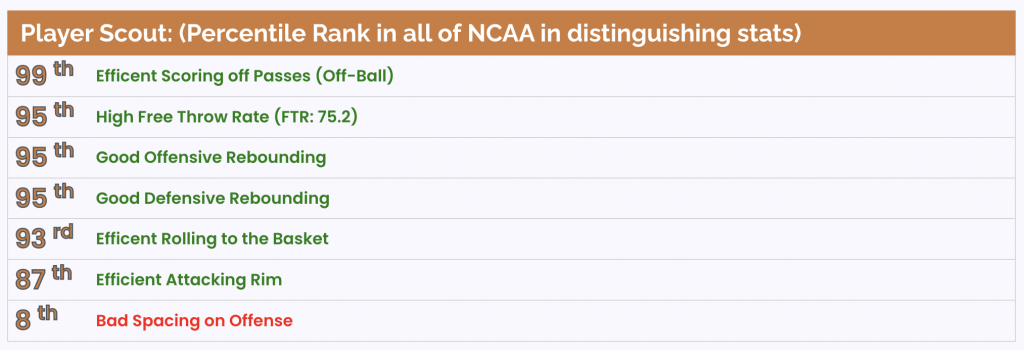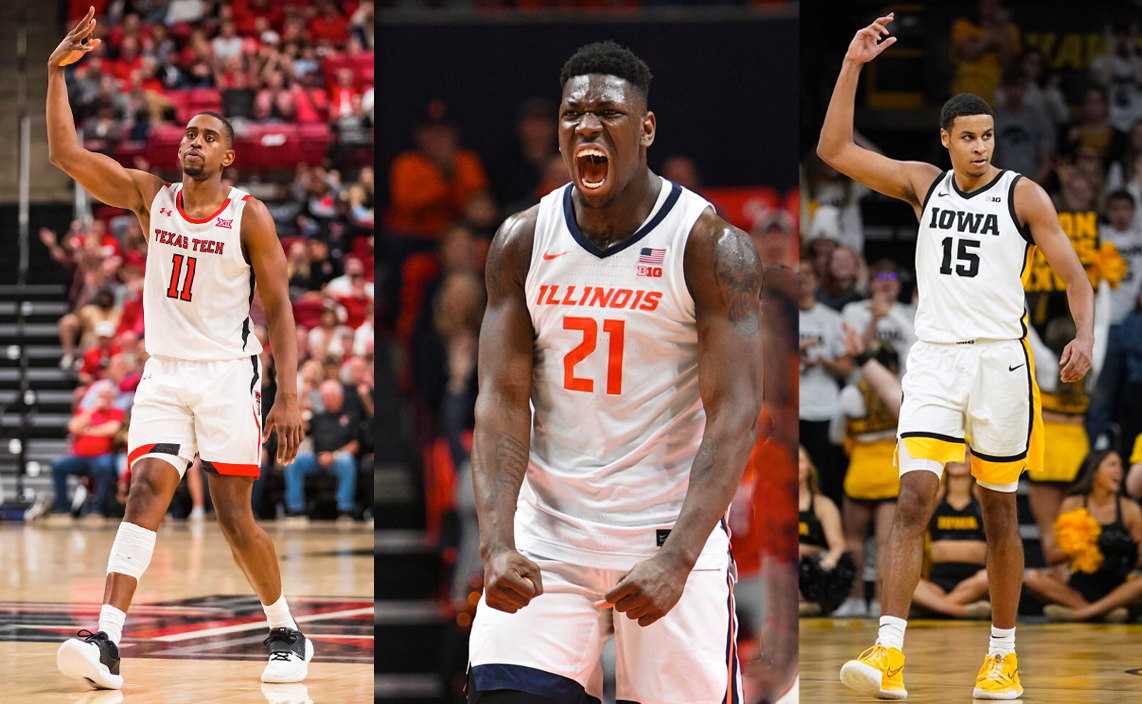Everyone loves a good Cinderella in March — a plucky double-digit seed who, through some combination of spunk, hot shooting, and late-game heroics, captures the nation’s attention on an improbable run through the NCAA tournament. These teams are, by nature, unpredictable; after all, that’s the fun of it.
The tier above the Cinderellas and below the favorites — the one- and two-seeds that everyone has pegged as Final-Four-bound — is where potential unlikely March Madness contenders can be found. Teams seeded 3 through 6 have won six NCAA championships since 1985; meanwhile, two-seeds have won just five NCAA tournaments in that span.
Here, we’ve identified some teams that have résumés that keep them off the short list of elite squads this season, but according to ShotQuality’s advanced statistics, might be underrated heading into March. If you’re looking for an offbeat Final Four choice for your bracket but don’t want to totally go off the deep end with a Cinderella prediction, look no further than these three squads.
 Texas Tech
Texas Tech
5th in Adjusted Shot Quality, current 3-seed according to Lunardi’s Bracketology
After the departure of head coach Chris Beard to in-state rival Texas, some pundits speculated that the Red Raiders would struggle to maintain their recent success under Mark Adams, the assistant coach Texas Tech tapped to take the reins. Instead, in his first year as head coach, Adams has his squad looking like the most formidable Texas Tech team since the 2018-19 roster that finished just one game short of cutting down the nets in March.
Defense is where this team’s bread is buttered, and when they’re playing energetically and fully locked-in, there might not be a higher-upside defensive team in the country. They lead the nation in Adjusted Defensive Shot Quality, allowing just 0.9 expected SQ Points Per Possession. In the half-court, that number plunges to a stingy 0.74 SQ PPP allowed. Guard Clarence Nadolny is the only player in their rotation shorter than 6’5”, and their defensive length and physicality has given opponents fits this season — especially at home, where the Red Raiders finished an undefeated 18-0.
On offense, Texas Tech is one of the best teams in the country at finishing around the rim, with the four-man wrecking crew of Bryson Williams, Kevin McCullar, Terrence Shannon, and Davion Warren perpetually generating quality looks at the basket. 43% of Texas Tech’s possessions finish with shots at the basket, and they’re scoring 1.19 SQ PPP on those looks, good for 17th in the country.
The Red Raiders are also elite at turning defense into offense, a valuable skill to have when points become hard to come by in the postseason. They rank 17th in the country in forcing turnovers and 4th in transition SQ PPP.

Things aren’t all sunshine and roses for Texas Tech. Their three-point shooting is spotty at best; Oral Roberts transfer and former Cinderella Kevin Obanor has helped a little bit in that department operating as a stretch four, but besides Bryson Williams (43.7% from three on 2.4 attempts per game), no one in the rotation makes even 35 percent of their triples. On defense, there is also a chink in the armor: 46.7% of their opponent’s shots have been threes this year, the 12th-highest mark in the NCAA; allowing lots of triples has proven a great defensive strategy over the course of the season, but if their opponent can get hot from three, the tactic could come back to bite Adams and the Red Raiders.
At the end of the day, though, Texas Tech is on the verge of being one of the five best teams in the country. If their strategy of getting to the basket, getting to the line, and getting stops — three things they do better than just about anyone — can translate to March, Adams and his experienced squad could be looking at a repeat of their 2018-19 run, perhaps with an even happier ending.
 Illinois
Illinois
7th in Adjusted Shot Quality, current 4-seed according to Lunardi’s Bracketology
Illinois’s roster is almost custom-built to put together a deep run in March. Perhaps the most appealing part of their NCAA tournament case is how devilishly simple their recipe for success seems to be.
They have perhaps the most dominant big man in the country in Kofi Cockburn. In his third season, the 7’0” 285-pound behemoth is averaging an eye-popping 21.5 points and 10.7 rebounds per game, and he’s proven an ability to will the Fighting Illini over high-quality competition — look no further than his 37-point performance on 16-19 shooting against Wisconsin in a win. Cockburn dominates every aspect of the paint; he ranks at or above the 85th percentile in the NCAA in scoring off his teammates’ passes, offensive rebounding, defensive rebounding, finishing as a roll man, finishing at the basket, and drawing free throws.

Around Kofi, the Illini have three three-point gunners ready to capitalize on the attention Cockburn creates with his mere presence around the basket. They bolstered last season’s pairing of Trent Frazier and Jacob Grandison with the addition of Utah marksman Alfonso Plummer on the transfer market; this season, that trio has attempted an average of 18.5 combined threes per game and knocked them down at a 39.5% clip.
They have three players at or above the 85th percentile in SQ PPP — Cockburn, Plummer, and Grandison — with over 250 possessions used, a feat few teams in college basketball can claim. Illinois can beat opponents in the paint or from beyond the arc, and their variety of offensive punches and counter-punches have blended to give the Illini an Adjusted Offensive Shot Quality of 1.25, seventh-best in the nation.
Again, Illinois isn’t without their flaws. Their transition defense is terrible — they’re allowing 1.07 SQ PPP on transition possessions, 323rd in the country. They get to the basket less frequently than 336 teams, and force fewer turnovers on defense than 328 teams. Those easy shots that Texas Tech generates so frequently simply aren’t a part of Illinois’s style. And against the best of the best, elite guards will make Kofi Cockburn defend in space and challenge his defensive limitations; opposing possessions against the Illini already end in pick-and-roll ball screen shots 30% of the time, the second-highest rate in the NCAA.
However, if Kofi can monopolize the paint the way he has all season, and the shooters around him can maintain their season averages, it might not matter. At the end of the day, Illinois has one of the best players in college basketball, and a roster perfectly built to capitalize on the gravity he commands. Their 20-8 record won’t be good enough to earn an elite seed, but it would not be a surprise to see this Illinois squad in the final rounds of the Big Dance.
 Iowa
Iowa
12th in Adjusted Shot Quality, current 7-seed according to Lunardi’s Bracketology
There’s something to be said for a team that knows exactly who they are, and Fran McCaffery’s Iowa squad certainly has that strong identity. Their defensive deficiencies may be their downfall come tournament time — a starting lineup featuring defensive sieves Jordan Bohannon and Patrick McCaffery might just not be up to snuff on the perimeter, and whether they go big with Filip Rebraca at center or small with Keegan Murray at the five, it could not be good enough. However, if you’re seeking a mid-seed squad to pick as a potential Cinderella, Iowa is the best option.
The case for Iowa starts with Keegan Murray, arguably the most versatile scorer in college basketball. Keegan is averaging 23.3 points per game this year, shooting an eye-popping 64% on twos and 37% on threes. His ShotQuality player info page is the epitome of a three-level scorer: Murray ranks above the 90th percentile in SQ PPP in drives and post-ups on either block, above the 70th percentile in SQ PPP from every area of the midrange, and above the 50th percentile in SQ PPP for catch-and-shoot and off-dribble threes.

Murray’s dominance extends to both ends of the floor as well. Even while shouldering the offensive load for the Hawkeyes, he also ranks in the 99th percentile in blocks, the 92nd percentile in steals, and the 90th percentile for both offensive and defensive rebounding. Opponents shoot 8 percent worse at the rim against Iowa with Murray on the floor. Murray is perhaps the most versatile elite player in the nation.
Alongside Keegan Murray, the Hawkeyes have assembled a motley crew of secondary scoring options. In his sixth season at Iowa, Jordan Bohannon has reached his final form as a three-point gunner. The veteran is shooting 6.6 threes per game at a 37% clip, and ranks in the 99th percentile in ShotQuality’s player gravity statistic. Kris Murray, Keegan’s brother, is a versatile bench scorer who can knock down open threes and attack the basket with straight-line drives and cuts. Patrick McCaffery hasn’t been particularly efficient this season, but he can get his own shot off from anywhere on the floor and is averaging 10.7 points this year.
With Joe Toussaint and Ahron Ulis as table-setters, the Iowa offense knows where their bread is buttered. They turn the ball over less frequently than any team in the nation while playing at the 32nd-fastest pace. The Hawkeyes might be undone by their lack of defensive upside come tournament time, but they will go as far as Keegan Murray — a bona fide two-way three-level scoring wing superstar — can take them.
By Ben Wieland
